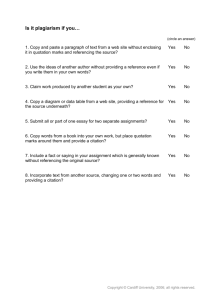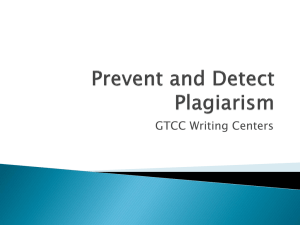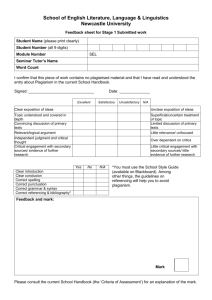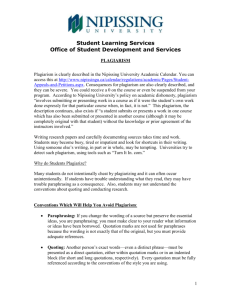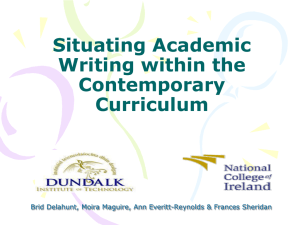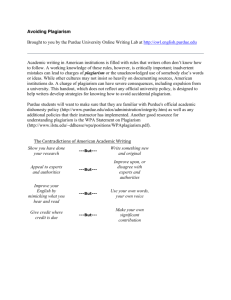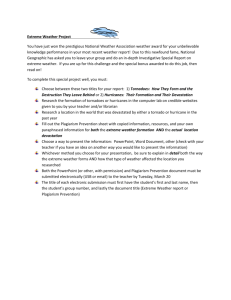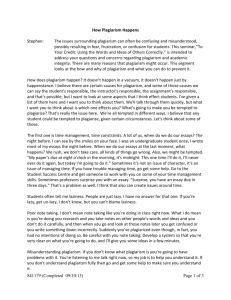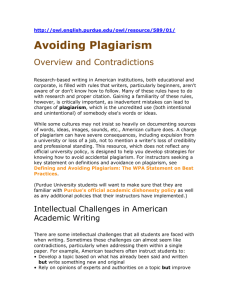GUIDELINES AND CRITERIA FOR WRITTEN ASSIGNMENTS
advertisement
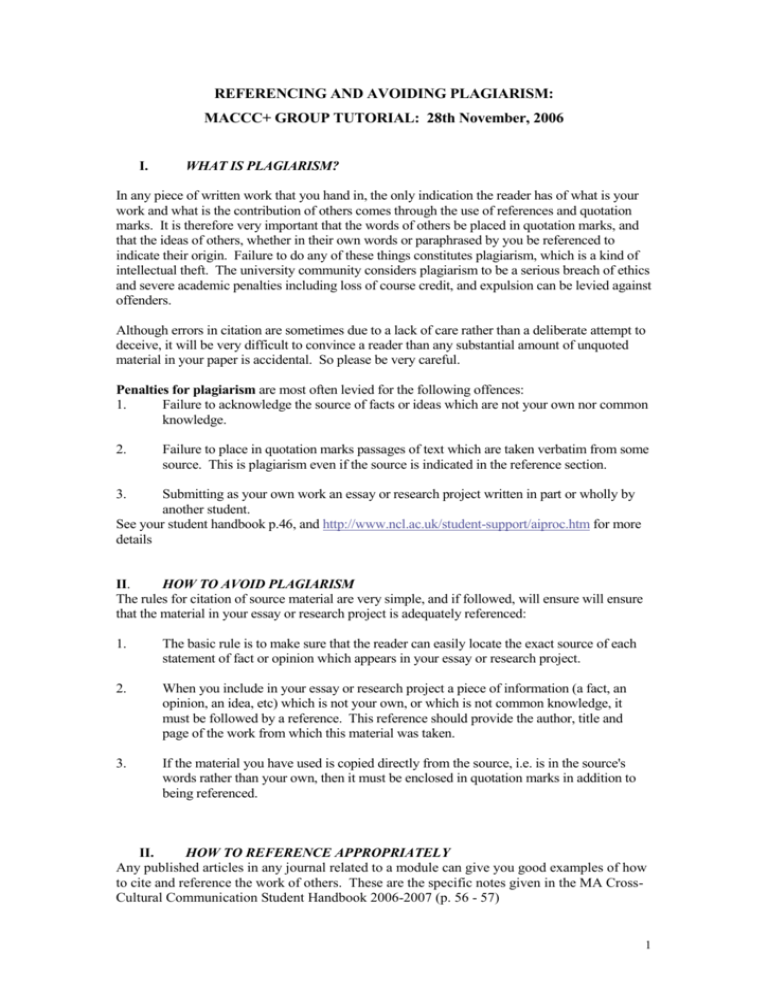
REFERENCING AND AVOIDING PLAGIARISM: MACCC+ GROUP TUTORIAL: 28th November, 2006 I. WHAT IS PLAGIARISM? In any piece of written work that you hand in, the only indication the reader has of what is your work and what is the contribution of others comes through the use of references and quotation marks. It is therefore very important that the words of others be placed in quotation marks, and that the ideas of others, whether in their own words or paraphrased by you be referenced to indicate their origin. Failure to do any of these things constitutes plagiarism, which is a kind of intellectual theft. The university community considers plagiarism to be a serious breach of ethics and severe academic penalties including loss of course credit, and expulsion can be levied against offenders. Although errors in citation are sometimes due to a lack of care rather than a deliberate attempt to deceive, it will be very difficult to convince a reader than any substantial amount of unquoted material in your paper is accidental. So please be very careful. Penalties for plagiarism are most often levied for the following offences: 1. Failure to acknowledge the source of facts or ideas which are not your own nor common knowledge. 2. Failure to place in quotation marks passages of text which are taken verbatim from some source. This is plagiarism even if the source is indicated in the reference section. 3. Submitting as your own work an essay or research project written in part or wholly by another student. See your student handbook p.46, and http://www.ncl.ac.uk/student-support/aiproc.htm for more details II. HOW TO AVOID PLAGIARISM The rules for citation of source material are very simple, and if followed, will ensure will ensure that the material in your essay or research project is adequately referenced: 1. The basic rule is to make sure that the reader can easily locate the exact source of each statement of fact or opinion which appears in your essay or research project. 2. When you include in your essay or research project a piece of information (a fact, an opinion, an idea, etc) which is not your own, or which is not common knowledge, it must be followed by a reference. This reference should provide the author, title and page of the work from which this material was taken. 3. If the material you have used is copied directly from the source, i.e. is in the source's words rather than your own, then it must be enclosed in quotation marks in addition to being referenced. II. HOW TO REFERENCE APPROPRIATELY Any published articles in any journal related to a module can give you good examples of how to cite and reference the work of others. These are the specific notes given in the MA CrossCultural Communication Student Handbook 2006-2007 (p. 56 - 57) 1 All references should be listed in alphabetic order of authors’ surnames. The style exemplified below could be used; your referencing conventions must be consistent. Different disciplines have slightly different referencing conventions- please check with Module Leaders if you are unsure. Here are some specific examples which are suitable for your Language and Communication modules: Journal article: Hofstede, G. (1994). The business of international business is culture. International business review, 3(1), 1-14. Chapter in an edited book: Shegloff, E. (1972). Sequencing in conversational openings. In J. Gumperz & D. Hymes (Eds.), Directions in Sociolinguistics (pp. 346-380). New York: Holt, Rinehart, and Winston. Book: Jandt, F. E. (2001). Intercultural communication. Thousand Oaks: Sage. Unpublished dissertation: Graham, J. L. (1980). Cross-cultural sales negotiations: A multilevel analysis. Unpublished doctoral dissertation, University of California. Conference paper: Chuang, R., & Krishna, V. (1994). Gender and culture differences in relationship termination: A study of causes and strategies of European American and Asian/Asian American romantic relationship disengagers. Paper presented at the annual meeting of Central States Communication Association, Oklahoma City. Reference which you have taken from another citation: Zekulin, I. (1930). Quoted in James, E. C (1945), Artifacts in Behavioural Research (pp. 35-36). New York: Academic Press. On-line sources: A few scenarios: a. if you can find out the author of the title, just list the author in the same way as the book author, except you need to cite where it is accessible; e.g. Androutsopoulos, J., & Scholz, A. (1999). On the recontextualisation of hip-hop in European speech communities: A contrastive analysis of rap lyrics. Available at http: //www.archetype.de/hiphop/ascona.html. b. if you cannot find out the author, but can dig up which organisation/company the webpage is attached to, list the source in the following way: BBC (2003, December). Country profile: New Zealand. Retrieved 4 December, 2003 from http://news.bbc.co.uk/1/hi/world/asia-pacific/country_profiles/1136253.stm c. if you fail to find the author or the organisation/company, you can use 'anonymous' in the place of author. If you have more than two anonymous authors, use a, b, c, etc. to differentiate them. For example: Anonymous a. (2000, December). Another cut of Internet access fee: Only 1 dollar per hour. Retrieved December 4, 2000 from http://cndaily.sina.com/headline/techheadlin/2000/1204/2334597.html. Anonymous b. (2003, December). etc. etc. 2 References cited in the text: Scollon & Scollon (1995, p. 123) argues that … Jefferson (1984, cited by Atkinson, 1986) claims that … In ‘Communication theory for a globalizing world,’ Peter Monge laments the fact ….(1998, p. 4) IV PRACTICAL TIPS These ideas are offered as a way of helping you at avoid plagiarism, and as a general help to you in producing good quality, properly sourced written work. Begin preparation early The research required to produce good essays, assignments and dissertations takes time. Plan your work carefully, and allow lots of time for research, preparation and writing up your work. This will help to avoid panic situations where plagiarism can easily occur as you rush to meet deadlines. Make notes as you go Be sure when you are doing research that you also carefully note where you have found your information (e.g. title, author, page(s), year, etc). You will need this for documenting your sources and creating bibliographies for your assignments. If you try to remember all the places that you have got your information from at the end of writing your work you will have problems- keep a record as you go. An annotated bibliography is very useful- the basic reference details (author, year…) but also a brief summary of contents. Be aware that formats may vary slightly between disciplines and modules The degree programme you are undertaking is very cross-disciplinary. You may therefore be expected to use specific styles of documentation which differ slightly on occasion. Check with the module leader and/or module overview documents on what style is appropriate if you are not sure. Don’t ‘self-plagiarise’ Work submitted for credit in one module may not be repeated verbatim for credit in other modules. 3
